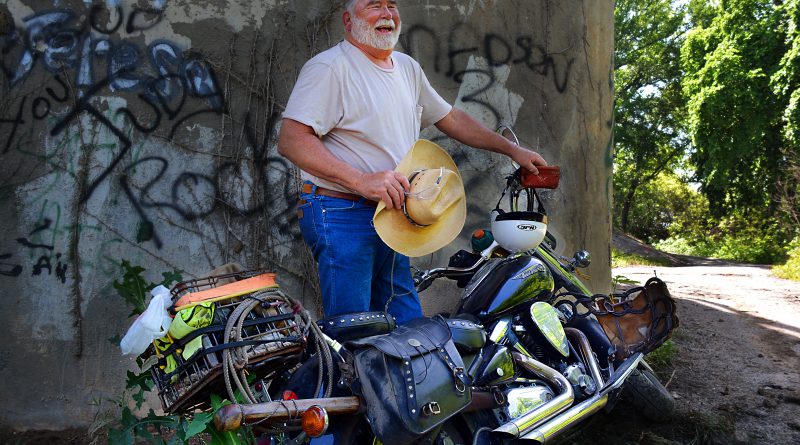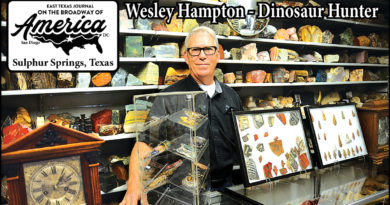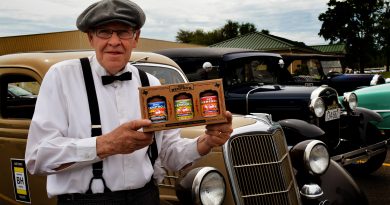Last Cowboy on the Bankhead, Press follows Truitt tour into Texas*
Author Dan Smith put the history of the Bankhead Highway in words. Texas Historical Commission Historic Resources Survey Coordinator Leslie Wolfenden put it on the state tourism map. Retired Professor Dale Truitt put the show on the road with a 4-day antique car tour that put the century-old highway known as “The Broadway of America” in the news from Texarkana to Odessa.
Between Texarkana and Sulphur Springs, space ships might have gotten similar reactions when Mr. Truitt’s convoy of 48 vintage cars looped through school campuses. At Caddo Mills, the high school band played. In Garland the Mayor presented them the key to the city.
“It’s as well organized as any tour I’ve driven,” Mt. Pleasant native Gary Gray said when he rolled into his old hometown in a 1940 Chevy and stopped for a hamburger lunch served on the Chamber of Commerce lawn.
As it turns out, that narrow niche of tourists lured by the “historic resources” (read as anything highway related from gas stations and motels to road signs) is a real. Here in the Geezerplex, Mt. Vernon’s taken an early lead in hosting passing visitors. The same day the vintage cars came through, a convoy of women pulling travel trailers came in from the west and turned off to camp on Lake Cypress Springs.
“We’ve got four rules,” said Tonja Avis, a Texas member of Sisters on the Fly. “No men, no kids, no pets, be nice.”
After breaking up in downtown Dallas traffic, the Truitt Convoy pulled together again in Arlington, turning into a wending lane through a live oak campus as they climbed “Top of the Hill Terrace,” once a thriving underworld den of music, gambling, dancing and ladies of the night, making a last bend around the statue of J. Frank Norris, “The Fightin’ Fundamentalist. Vehemently opposed to gambling and prostitution,” at a tent meeting in the 1930 witnesses recalled his prophesying the church’s taking Terrace Hill – which actually happened in 1956 when it was purchased and became Bible Baptist Seminary, now Arlington Baptist College.
An 850-mile back road from Texarkana to El Paso, the route of the historic Bankhead bypasses loops in favor of turning across small-town Texas squares. In Palo Pinto County, it passes the well preserved skeleton of the long-since abandoned Baker Hotel, once a 450-room resort.
“Now, I’ll show you where we really are,” said Dr. Tom Sloan. Piloting our chase convertible, the doctor dipped us south into Saturday afternoon in the Palo Pinto County Seat where the only things open were a convenience store and the jailhouse museum.
It’s the heart of the country that inspired John Graves to write “Goodbye to a River,” a lament about civilization encroaching on the Texas frontier, a book stuffed with anecdotal history of cattlemen and Comanches, homesteaders and the hermits who’d lived along the river when he was growing up in the 30’s and 40’s.
We came upon maybe a modern-day version of the same cut, the biker on the cover we encountered under the bridge over the Brazos. He had a lariat lashed on the milk crate on his Harley. Horse shoes made a frame for his foot-rest highway bars.
Lonesome Dove author Larry McMurtry found the mold for his fictional characters here in the story of Charles Goodnight, arguably the first Anglo rancher in Texas and Oliver Loving, who established three major cattle trails.
Mr. Loving shared the fate of McMurtry’s mythical Augustus McRae, except it was real. Scouting ahead of a herd of 2,000 longhorns they were driving to New Mexico, Loving was wounded in an Indian fight and lay five days without food before his rescue. When he died of gangrene in 1867, his dying wish was fulfilled when Goodnight brought him 600 miles back to Texas for burial.
At the Palo Pinto County museum, docent Freeda Hose said during his time in the country, Loving and his brother were occasionally arrested and charged with selling whiskey to Indians. Asked how she’d know such a thing, she said, “Honey, I know everything,” and reaching under the counter pulled out the record books opening into a Texas tale on the side of an old road.



